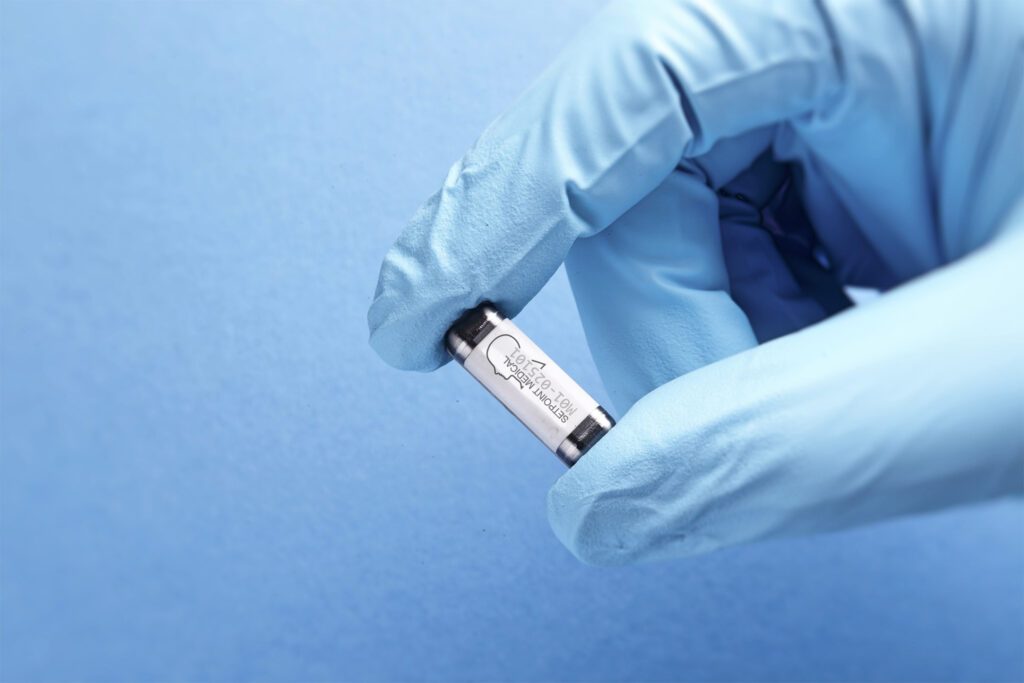Pioneer Neuroimmune Modulation

A novel approach to treat rheumatoid arthritis
Neuroimmune modulation is a treatment approach that activates neural pathways to modulate the immune system. For conditions like rheumatoid arthritis, or RA, this can be achieved by electrically stimulating the vagus nerve. The SetPoint System includes a small, rechargeable, integrated neurostimulator enclosed in a ceramic and titanium case that is placed directly on the left vagus nerve to deliver precise electrical pulses to treat RA.
A new treatment platform designed to restore the immunologic setpoint
The vagus nerve senses and reflexively governs the homeostatic control of both immune responses and restorative pathways through these innate neuroimmune reflexes.1
Electrically stimulating specific fibers of the vagus nerve with precise parameters activates cholinergic anti-inflammatory pathways that restore the immunologic setpoint and reduce the release of inflammatory cytokines that are implicated in RA disease activity and progression.2,3,4
SetPoint System is clinically proven to safely and effectively treat RA for adults with active disease and inadequate response or intolerance to one or more biologics or targeted synthetic drugs.
Novel treatment option
Safe and proven treatment for biologic-experienced RA
Content goes here ..
Gives you back control of therapy choices
Content goes here ..

How it works
The SetPoint System includes a small, leadless, integrated neurostimulator enclosed in a ceramic and titanium case that is placed directly on the left vagus nerve during an outpatient procedure. Once activated, integrated telemetry and a rechargeable battery in the SetPoint Implant is designed to automatically deliver therapy for one minute each day, for up to 10 years.
Resources



Frequently asked questions about the SetPoint System
How does the vagus nerve control inflammation?
The vagus nerve plays a central role in modulating inflammation.1,5 Excessive inflammation plays a role in causing and advancing many autoimmune diseases, such as rheumatoid arthritis (RA). The sensory neurons within the vagus nerve detect and respond to inflammatory mediators by sending signals to the brainstem.5 Signals reflexively travel back into the body through motor fibers within the vagus nerve to enact the homeostatic control of both immune responses and restorative pathways through linked innate neuroimmune reflexes.2,5
This pathway is thought to be dysfunctional in patients with RA6, causing increased inflammation that contributes to pain and swelling of the joints, putting patients at risk of joint deformities and disability if not well managed. Electrically stimulating the vagus nerve with precise parameters activates specific fibers of the vagus nerve that activate cholinergic anti-inflammatory processes that are intended to restore immunologic balance and reduce the release of inflammatory cytokines.2,3,4
How do you place the SetPoint Implant?
The SetPoint System includes a small, leadless, integrated neurostimulator that is placed directly on the left vagus nerve through a single incision during an outpatient procedure under general anesthesia. The implant is placed on the nerve within a flexible silicone Pod.
To implant the device, the vagus nerve is accessed, and then the Pod is placed under and around the nerve. The Implant is then placed in the Pod, which is then sutured closed, holding the neurostimulator against the vagus nerve.
An integrated, leadless implant with rechargeable battery means there is no need to coil electrodes around the nerve, tunnel the lead, or to create a chest pocket for a separate battery or generator.
What patients are indicated for the SetPoint System?
The SetPoint System is indicated for adult patients with moderately to severely active RA who have had an inadequate response, loss of response, or intolerance to one or more biologic (e.g. TNF inhibitors) or targeted synthetic RA drugs (e.g. JAK inhibitors).
Can you tell me more about reimbursement for the SetPoint System?
Billing codes for the single incision implant, replacement, and removal procedures for the SetPoint System have been established. We have worked with the American Association of Neurological Surgeons (AANS), Congress of Neurological Surgeons (CNS), and American College of Rheumatology (ACR) to establish these CPT codes.
SetPoint Therapy is covered by insurances on a case-by-case basis, subject to prior authorization.
SetPoint Medical’s commitment to making SetPoint therapy accessible to patients means that we will work directly with the referring rheumatologist and the surgical facility to help seek prior authorization for the SetPoint implant procedure on your patient’s behalf. You, your team, and your patients will be kept informed throughout the process to ensure a best-in-class experience.
Is the SetPoint System safe and effective?
The SetPoint System is clinically proven to effectively treat RA for adults with active disease and an inadequate response or intolerance to one or more biologics or targeted synthetic drugs.
The SetPoint System’s safety and effectiveness were studied in the RESET-RA study that enrolled 242 patients across multiple study sites in the U.S. The study successfully met its primary endpoint of ACR20, a composite endpoint designed by the American College of Rheumatology (ACR) to assess clinical efficacy of RA therapies. Additionally, with 12 months of therapy, nearly 50% of patients were in low disease activity or remission* — the primary treatment target recommended in ACR’s RA treatment guidelines.*
The safety data indicated that the SetPoint System, as well as its implant procedure, were safe with a related, serious adverse event rate of 1.7% (n =4) in the peri-operative 3 months, and with no unanticipated adverse events, and no (0%) related serious events through 12 months of long-term follow-up. Specifically, through 12 months, there were no malignancies, cardiac issues, or serious infections associated with SetPoint Therapy.
Learn more on the Clinical Evidence page.
*Analysis based on patients who were treated with SetPoint Therapy for 12 months without the addition of biologic, JAK inhibitors or high-dose steroids, or change in csDMARDs.
How does the vagus nerve control inflammation?
The vagus nerve plays a central role in modulating inflammation, which plays a role in causing and advancing many autoimmune diseases including rheumatoid arthritis (RA). The sensory neurons of the vagus nerve detect and respond to inflammatory mediators by sending signals to the brainstem. A signal reflexively travels down the efferent arc to govern the homeostatic control of both immune responses and restorative pathways through these innate neuroimmune reflexes.
This pathway is thought to be dysfunctional in patients with RA, leading to increased inflammation that causes pain and swelling of the joints, and can lead to joint deformities and disability if not well managed. Electrically stimulating the vagus nerve with precise parameters activates specific motor pathways within the vagus nerve that activate cholinergic anti-inflammatory pathways that restore immunologic balance and reduce the release of inflammatory cytokines.
How do you place the SetPoint Implant?
The SetPoint System includes a small, leadless, integrated neurostimulator that is placed directly on the left vagus nerve through a single incision during an outpatient procedure. The leadless implant is placed on the nerve within a flexible silicon Pod.
Once the vagus nerve is accessed, the Pod is first placed under the nerve. The Implant is then placed in the Pod, which is then sutured closed. An integrated, leadless implant with rechargeable battery means there is no need to coil electrodes around the nerve, to tunnel the lead or create a chest pocket for a separate battery or generator.
Please see complete placement instructions in the Surgical Manual.
What patients are indicated for SetPoint System?
The SetPoint System is indicated for patients with active, moderate to severe RA who have had an inadequate response, loss of response, or intolerance to one biologic or targeted synthetic DMARD. The SetPoint Hub will work to partner you with rheumatologists in your area who will refer eligible patients to your practice for surgical consideration.
Can you tell me more about reimbursement for SetPoint System?
Billing codes for the single incision implant, replacement, and removal have been established. For more information, contact us. SetPoint therapy is covered by insurances on a case by case basis, subject to prior authorization.
SetPoint’s commitment to seamless experience means that we will work directly with the referring rheumatologist and the surgical facility to prior authorize the SetPoint implant procedure on your patient’s behalf. You, your team, and your patients will be kept informed by our SetPoint Activator to ensure a best-in-class experience.
Is it safe and effective?
SetPoint System is clinically proven to effectively treat RA for adults with active disease and inadequate response or intolerance to one or more biologics or targeted synthetic drugs.
SetPoint System’s safety and effectiveness were studied in the RESET-RA study that enrolled 242 patients across multiple study sites in the U.S. The study successfully met its primary endpoint of ACR20, a composite endpoint designed by the American College of Rheumatology (ACR) to assess clinical efficacy of RA therapies. Data available through 12 months of follow up indicated that nearly half the patients were in low disease activity or remission – the primary treatment target recommended in ACR’s RA treatment guidelines.
The safety data indicated that SetPoint System as well as its implant procedure were safe with only 1.7% related, serious adverse event rate in the peri-operative 3 months, no unanticipated adverse events and zero related serious events through 12 months of follow up. Specifically, through 12 months, there were no incidences of related malignancies, cardiac issues, or serious infections – safety risks typically associated with traditional drug-based RA therapies.
Connect With Us

2. van Maanen MA, et al. The cholinergic anti-inflammatory pathway: towards innovative treatment of rheumatoid arthritis. Nat Rev Rheumatol. 2009;5(4):229-232.
3. Kelly MJ, et al. Manipulation of the inflammatory reflex as a therapeutic strategy. Cell Rep Med. 2022;3(7):100696.
4. Levine YA, et al. Harnessing the Inflammatory Reflex for the Treatment of Inflammation-Mediated Diseases. Cold Spring Harb Perspect Med. 2020;10(1):a034330.
5 Tracey KJ. The inflammatory reflex. Nature. 2002;420(6917):853-859.
6. Koopman FA, et al. Autonomic Dysfunction Precedes Development of Rheumatoid Arthritis: A Prospective Cohort Study. EBioMedicine. 2016;6:231-237.